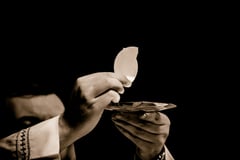Eucharist
The Sacrament of the Holy Eucharist (Holy Communion) is “the source and summit of the Christian life.” (Catechism of the Catholic Church, 1324). During the Mass, we gather around the Lord’s table and remember Christ’s Passion, sacrifice on the cross, His Resurrection, and His Ascension as Jesus instructed us during the Last Supper.
As Catholics, we believe in transubstantiation - the transformation of bread and wine into the true Body and Blood of Jesus Christ. We ask that only “properly disposed” Catholics receive Holy Communion. This means that the receiving of Jesus’ Body and Blood is set aside for Catholics who are in right relationship with God and with one another. The intention here is not to dissuade anyone from receiving Communion; rather, it is an invitation to heal what is broken, creating a suitable environment for Jesus. The Church recommends going to Confession regularly prior to receiving Communion during Mass.

Sacrament of the Eucharist
What would make us worthy to receive Holy Communion? Simple answer: nothing. We are never worthy of so great a gift. But here’s the exciting part: God offers us this great sacrament freely. So why...
The Meaning of the Eucharist
As a little girl, when I prepared for my First Holy Communion I learned that Jesus was present in the bread and wine. But for many years, I would go to mass and go through the motions Sunday after...
5 Things to try if you find the homily boring
How is a well-meaning Catholic to keep from daydreaming or nodding off if the priest isn't dazzling? Chances are you’ve had to sit through at least one uninteresting homily in your life. Just like...First Holy Communion
Youth are prepared for First Holy Communion in the Catholic School and in the Parish School of Religion following the Diocesan Graded Course of Study and Diocesan Guidelines for celebrating the sacrament with children (usually on a Saturday in May).
Adults preparing to be received into the Church celebrate all of the sacraments of initiation (Baptism, Confirmation and Eucharist) generally at the Easter Vigil Liturgy. (RCIA)